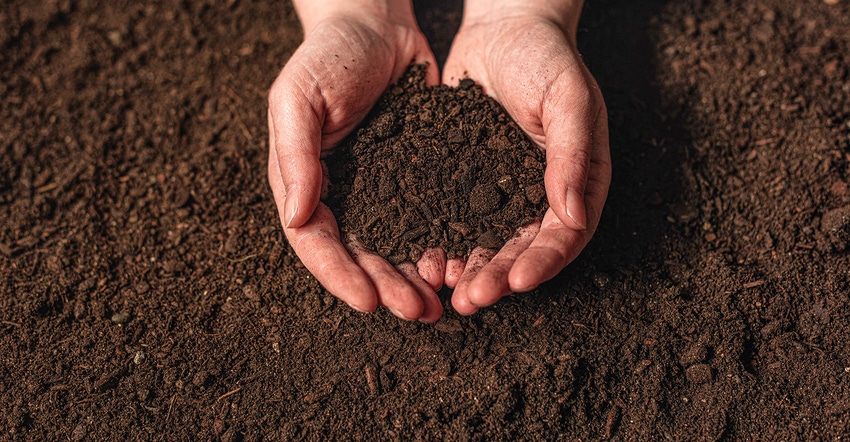
Tilling every year and going completely no-till are two extremes. According to Gary Zimmer, consultant and farmer as well as the founder and chief visionary officer of Midwestern BioAg, it is best to have a healthy balance to maintain the health of the soil.
During the online 2020 Sustainable Agronomy Conference put on by the American Society of Agronomy, Zimmer spoke on determining the health of the soil by examining all aspects of soil health — physical, chemical, and biological.
Biological farming
Zimmer defines biological farming as an approach to food production that respects the natural processes in the farm to yield top quality products, provide a viable living for the producer, and sustain long-term productivity.
"Going no-till and adding cover crops doesn't fit every farm, so biological farming is an approach which respects the natural process of farming," Zimmer said. "It respects the balanced relationship between the three aspects of soil, mainly the physical, chemical, and biological, which sustains life within the soil."
Physical has to do with aeration, soil aggregation, and drainage. The soil needs to drain; it can't be waterlogged. Chemical is the minerals in the soil as well as the pH of the soil. Examples of the biological aspect of soil health are cover crops, microbes, and organic matter. Each aspect is important to the soil's overall health and, therefore, the health of the plants growing in the soil.
"If you have all three of these working to maximum capacity on your farm," he said, "you will have healthy soils.
Soil health: Six rules
"I came up with what I call the six rules to biological farming. You will notice that within these six rules of biological farming, it touches on the chemical, physical, and biological aspects.
"First, however, we do want to test our soils, which helps to identify limiting factors. We want to know if we have too much or too little of something in the soil. We want balanced soil. Soil tests are helpful to provide information to make the appropriate soil correction. They don't tell you everything, though. It doesn't show the biology of the plant in the soil."
Zimmer's six rules of biological farming are:
1. Test and balance your soils as well as feed the crop a balanced supplemented diet.
2. Use fertilizers that do the least damage to soil life and plant roots. Watch salt and ammonia levels. Use a balance of nutrients with a balance of soluble for a slow release and a controlled pH. Use homogenized micronutrients, add carbon, and place them properly to enhance performance.
3. Use pesticides, herbicides, and nitrogen in minimum amounts and only when necessary.
4. Create maximum plant diversity by using green manure crops and tight rotations.
5. Use tillage to control the decay of organic materials and to control soil air and water. Zone tillage, which is shallow incorporation of residues, and deep tillage work great on many farms.
6. Feed the soil life, using carbon from compost, green manures, livestock manures, and crop residues. Apply calcium from a good, plant-available source.
Soil health depends on the soil's capacity to function without intervention. Healthy soil contains plant diversity, living roots, minerals, and residue decay. It also has water infiltration, nutrient cycling, minimum disturbance, and no crust.
"Once the soil is healthy, the objective is for the soil to be able to function without intervention and have that chocolate cake-like consistency," Zimmer said.
When to till
Tillage is a thoughtful disturbance of the soil.
"I tell people if you're going to go no-till, you have just tied your hands behind your back," he said. "But also, why would you till if you don't have to? You're trying to achieve this nice, crumbly soil. Only use tillage if you need too. Probably, 5% to 10% of the land that's farmed never needs to be tilled, but everything else is going to need intervention.
"To till or not to till, that is the question. Can you have healthy soils with tillage? Oh, absolutely. Shallow tillage can help the soil, but aggressive tillage upsets the system."
Shallow tillage to incorporate residues and deep ripping are tools of today's organic farmers. Also, learn to live with some residues near the surface.
No-till and plowing are both extremes. Somewhere in the middle is where you want to be.
Questions to consider when deciding on whether to till:
1. Can you have healthy soils if you till?
2. Are nutrients (residues) sitting on top of the ground?
3. What is your reason to till?
"You need a good reason to till," Zimmer said. "Why would you aggressively plow or aggressively till if you don't have too? Sometimes every five or 10 years, aggressive tillage may be essential, and remember, not all soils are suited to be no-till.
"My definition of sustainability is 25 earthworms per cubic foot of soil and zero soil loss. If you achieve that, you're at a level I call sustainable. Healthy soil produces a healthy plant, and a healthy plant produces healthy soil."
For more information on soil health and soil testing, call your county Extension office, or check your state’s Extension website.
About the Author(s)
You May Also Like




